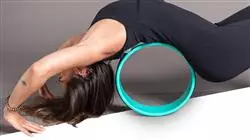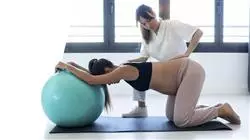University certificate
Scientific endorser

The world's largest faculty of sports science”
Introduction to the Program
With TECH, you will update your skills as a Pilates Instructor, its techniques, and most efficient exercises for proper physical training”

In the field of Sports Science, there has been a growing interest in the role of Pilates as an effective tool to improve the health and well-being of pregnant women and patients with musculoskeletal pathologies. For this reason, the figure of the Pilates Instructor becomes a key element in addressing different problems from a discipline that has been consolidated over time.
In this way, a physical trainer updated in the techniques used by Pilates Instructor will be able to adapt specific exercises for pregnant women or adapt each of them to athletes in the recovery process from injuries. In this context, TECH has developed this Postgraduate diploma designed to guarantee specialists a complete update in the field of Pilates Instructor.
In this regard, a wide-ranging update is offered on the exercises suitable for each stage of pregnancy, as well as on the changes in body statics during this period. In addition, the most frequent problems that may arise during pregnancy will be addressed, indicating recommended exercises and relevant contraindications for safe and effective care. You will also expand your knowledge of pathologies of the Nervous System and their relationship with the implementation of Pilates.
Likewise, the degree is offered in 100% online mode, which will allow the expert to carry out their update without leaving their daily activities aside since they will not have to adapt to a strict schedule. In addition, this methodology implemented by TECH is combined with the Relearning system, which will ensure that you will remember the concepts more easily and efficiently. All this together in a virtual library that will be accessible to students without time restrictions.
You will delve into pathologies of the Nervous System and the implementation of the benefits of Pilates for the treatment of diseases”
This Postgraduate diploma in Pilates Monitor contains the most complete and up-to-date scientific program on the market. The most important features include:
- The development of practical cases presented by experts in Physiotherapy and Pilates
- The graphic, schematic, and practical contents with which they are created, provide scientific and practical information on the disciplines that are essential for professional practice
- Practical exercises where the self-assessment process can be carried out to improve learning
- Its special emphasis on innovative methodologies
- Theoretical lessons, questions to the expert, debate forums on controversial topics, and individual reflection assignments
- Content that is accessible from any fixed or portable device with an Internet connection
You will perform strength assessments, tests, and scales in neurological pathologies in order to execute the appropriate exercises in Pilates”
The program’s teaching staff includes professionals from sector who contribute their work experience to this educational program, as well as renowned specialists from leading societies and prestigious universities.
Its multimedia content, developed with the latest educational technology, will provide the professional with situated and contextual learning, i.e., a simulated environment that will provide an immersive education programmed to learn in real situations.
The design of this program focuses on Problem-Based Learning, by means of which the professional must try to solve the different professional practice situations that are presented throughout the academic course. For this purpose, the student will be assisted by an innovative interactive video system created by renowned experts.
You will implement in your professional practice the exercises indicated for the third trimester of pregnancy”

With this program, you will delve into the dilation and expulsion phases of pregnancy and the proper exercises for good practice during this process”
Syllabus
Thanks to this qualification, the fitness professional will be updated with the procedures, practices, and equipment used in the sessions carried out by a Pilates Instructor. In addition, the curriculum will be specially designed to address situations with pregnant women, pre-and post-natal difficulties, and people with neurological disorders. In addition, the program offers a series of innovative multimedia resources such as in-focus videos and real case studies, which will be available in a virtual library that can be accessed without restrictions, 7 days a week, 24 hours a day.

With the Relearning method, you will reinforce the concepts covered without having to invest long hours in this updating process"
Module 1. Pillars during Pregnancy, Childbirth and Postpartum
1.1. First Trimester
1.1.1. Changes in the first quarter
1.1.2. Benefits and objectives
1.1.3. Indicated exercises
1.1.4. Contraindications
1.2. Second quarter
1.2.1. Changes in the Second quarter
1.2.2. Benefits and objectives
1.2.3. Indicated exercises
1.2.4. Contraindications
1.3. Third Trimester
1.3.1. Changes in the third quarter
1.3.2. Benefits and objectives
1.3.3. Indicated exercises
1.3.4. Contraindications
1.4. Birth
1.4.1. Dilation and delivery phase
1.4.2. Benefits and objectives
1.4.3. Recommendations
1.4.4. Contraindications
1.5. Immediate Postpartum
1.5.1. Recovery and puerperium
1.5.2. Benefits and objectives
1.5.3. Indicated exercises
1.5.4. Contraindications
1.6. Urinary Incontinence and Pelvic Floor
1.6.1. Anatomy involved
1.6.2. Pathophysiology
1.6.3. Indicated exercises
1.6.4. Contraindications
1.7. Problems in pregnancy and approach through the Pilates Method
1.7.1. Body statics change
1.7.2. Most Frequent Problems
1.7.3. Indicated exercises
1.7.4. Contraindications
1.8. Pregnancy preparation
1.8.1. Benefits of physical training during pregnancy
1.8.2. Recommended physical activity
1.8.3. Indicated exercises for the first pregnancy
1.8.4. Preparation during the search for the second and subsequent
1.9. Late Postpartum
1.9.1. Long-term anatomical changes
1.9.2. Preparation for the return to physical activity
1.9.3. Indicated exercises
1.9.4. Contraindications
1.10. Post-partum alterations
1.10.1. Abdominal diastasis
1.10.2. Static pelvic-prolapse shift
1.10.3. Alterations of deep abdominal musculature
1.10.4. Indications and contraindications in cesarean section
Module 2. General pathology and its treatment with Pilates
2.1. Nervous system
2.1.1. Central Nervous System
2.1.2. Peripheral Nervous System
2.1.3. Brief description of neural pathways
2.1.4. Benefits of Pilates in neurological pathology
2.2. Neurological assessment focused on Pilates
2.2.1. Medical History
2.2.2. Strength and tone assessment
2.2.3. Sensitivity assessment
2.2.4. Tests and scales
2.3. Most prevalent neurological pathologies and scientific evidence in Pilates
2.3.1. Brief description of the pathologies
2.3.2. Basic principles of Pilates in neurological pathology
2.3.3. Adaptation of Pilates positions
2.3.4. Adaptation of Pilates Exercises
2.4. Multiple Sclerosis
2.4.1. Pathology description
2.4.2. Assessment of the patient's capabilities
2.4.3. Adaptation of Pilates exercises on floor
2.4.4. Adaptation of Pilates exercises with elements
2.5. Stroke
2.5.1. Pathology description
2.5.2. Assessment of the patient's capabilities
2.5.3. Adaptation of Pilates exercises on floor
2.5.4. Adaptation of Pilates exercises with elements
2.6. Parkinson’s Disease
2.6.1. Pathology description
2.6.2. Assessment of the patient's capabilities
2.6.3. Adaptation of Pilates exercises on floor
2.6.4. Adaptation of Pilates exercises with elements
2.7. Neurological assessment focused on Pilates
2.7.1. Pathology description
2.7.2. Assessment of the patient's capabilities
2.7.3. Adaptation of Pilates exercises on floor
2.7.4. Adaptation of Pilates exercises with elements
2.8. Older adults
2.8.1. Age-related pathologies
2.8.2. Assessment of the patient's capabilities
2.8.3. Indicated exercises
2.8.4. Contraindicated exercises
2.9. Osteoporosis
2.9.1. Pathology description
2.9.2. Assessment of the patient's capabilities
2.9.3. Indicated exercises
2.9.4. Contraindicated exercises
2.10. Pelvic Floor Disorders: urinary incontinence
2.10.1. Pathology description
2.10.2. Incidence and Prevalence
2.10.3. Indicated exercises
2.10.4. Contraindicated exercises
Module 3. The gym/Pilates studio
3.1. The Reformer
3.1.1. Introduction to the Reformer
3.1.2. Reformer Benefits
3.1.3. Main exercises on the Reformer
3.1.4. Main errors on the Reformer
3.2. Pelvic Floor Disorders: urinary incontinence
3.2.1. Introduction to Cadillac
3.2.2. Cadillac Benefits
3.2.3. Main exercises on the Cadillac
3.2.4. Main errors on the Cadillac
3.3. The chair
3.3.1. Introduction to the chair
3.3.2. Chair benefits
3.3.3. Main exercises on the chair
3.3.4. Main Errors on the chair
3.4. The Barrel
3.4.1. Introduction to the Barrel
3.4.2. Barrel Benefits
3.4.3. Main exercises on the Barrel
3.4.4. Main errors on the Barrel
3.5. "Combo" models
3.5.1. Introduction to the Combo model
3.5.2. Combo model benefits
3.5.3. Main exercises on the Combo model
3.5.4. Main Errors on the Combo model
3.6. The flexible ring
3.6.1. Introduction to flexible ring
3.6.2. Flexible ring benefits
3.6.3. Main exercises on the flexible ring
3.6.4. Main Errors on the flexible ring
3.7. The Spine Corrector
3.7.1. Introduction to Spine corrector
3.7.2. Spine corrector benefits
3.7.3. Main exercises on the Spine corrector
3.7.4. Main Errors on the Spine corrector
3.8. Implements adapted to the method
3.8.1. Foam roller
3.8.2. Fit Ball
3.8.4. Elastic bands
3.8.5. Bosu
3.9. The Space
3.9.1. Equipment preferences
3.9.2. The Pilates space
3.9.3. Pilates instruments
3.9.4. Best practices in terms of space
3.10. The Environment
3.10.1. Environment concept
3.10.2. Characteristics of different environments
3.10.3. Environment choice
3.10.4. Conclusions

You will closely examine the accessories used in Pilates, such as the Foam Roller, Fit Ball, and Elastic Bands, in order to enhance highly effective physical workouts”
Postgraduate Diploma in Pilates Monitor
Get certified in the best digital university in the world and reach new professional goals! This time we present the Postgraduate Diploma in Pilates Monitor, fully online for you to study from anywhere in the world. The regular practice of Pilates has demonstrated numerous health benefits, both physical and mental. Among them are the strengthening of the abdominal muscles, posture correction and injury prevention. In addition, Pilates helps to improve flexibility, coordination and balance, which is essential for maintaining a healthy and harmonious body. The program offers participants a complete and specialized training in this method of exercise.
Achieve the professional dreams you always imagined
This program has a highly qualified faculty with extensive experience in teaching Pilates. The teachers provide constant support to students, guiding them and providing them with the necessary tools to become successful professionals. The Pilates job market has experienced significant growth in recent years. More and more people are looking for physical activities that allow them to maintain a healthy and balanced body, and Pilates has become one of the most popular options. Therefore, professionals who study the Postgraduate Diploma in Pilates Instructor have ample job opportunities in gyms, sports centers, rehabilitation clinics, spas and wellness centers. This training is of great importance for those interested in entering the world of Pilates and wellness. This program offers a complete and specialized preparation, providing students with the knowledge and skills necessary to become excellent Pilates instructors and take advantage of the job opportunities in this constantly growing field.







